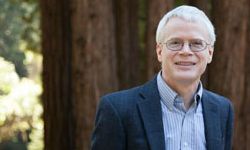In a time of increased insularity around the world, how does UC Santa Cruz broaden student—and faculty—interaction with ideas and views from around the state, country, and globe?
The divisions of Undergraduate Education and Global Engagement prepare low-income, first generation students for postsecondary education, work to expand the diversity of our undergraduate student body at UC Santa Cruz, and seek to offer experiences that challenge students intellectually and personally.
Just last week, some of this work was on display when Chancellor George Blumenthal spoke to hundreds of students at Pajaro Valley High School, as part of the Achieve UC initiative. Accompanied by a team from the Educational Partnership Center, the chancellor told a gym full of students that a UC education is affordable and attainable, and that they need to submit their UC application by Nov. 30. He joined a panel discussion about college life and even took a moment to read an aspiring astrophysicist’s essay for their UC Santa Cruz application.
Achieve UC and many more outreach efforts are run by our Educational Partnership Center (EPC), which just received a $10.5 million grant from the U.S. Department of Education to further build upon the existing college-bound communities in south Monterey County, joining existing programs and collaborations in the Pajaro Valley as well as Santa Clara, North Monterey, and Santa Cruz counties.
All of this work points to the partnerships, among schools, businesses, foundations, and governments, to continuously build the pipeline to college and future success. Developing a diverse class relies on connecting early and broadly to students to ensure their greatest success, and on bringing together experiences from places near and far.
Developing a diverse class also deeply involves our faculty. We work closely with the Academic Senate’s Committee on Admissions and Financial Aid (CAFA) to set local admissions strategies that help us to form a new undergraduate class from more than 60,000 applications. These strategies guide our efforts to recruit and enroll California transfer students, California high school students, students from out of California.
The Office of Undergraduate Admissions, in collaboration with other staff, faculty, students and alumni, has been an instrumental partner in the campus’s success in improving campus diversity. Now, 4 percent of undergraduates identify as African American, and 1 percent as American Indian. Further, beyond California, 3 percent are from 44 states and Puerto Rico, and 6 percent from 40 countries other than the United States.
These numbers, still small and needing to grow, enrich the campus experience for everyone by bringing in more experiences, cultures, and skills.
Banana Slugs abroad
After students arrive on campus, we also strive to diversify the experiences they have throughout their undergraduate career and ensure an inclusive campus environment.
Last week, I joined a systemwide meeting focussed on “getting to 30 percent”, doubling undergraduate participation in international study, research, and internship. Perhaps surprisingly, this is a challenging goal!
Last year, just 14 percent of our graduates had had some international educational experience after joining our campus, and 3 percent before joining.
Among other strategies, we are building new relationships with universities abroad, and helping create new opportunities for UC Santa Cruz faculty to teach courses and take students abroad. These integrated campus-led programs should increase opportunities for students from groups less represented in study abroad, as will our general work to enhance opportunities and accessibility to study abroad for all UC Santa Cruz students.
Undergraduate Education and Global Engagement also work extensively with units and divisions throughout campus to ensure all students feel welcome and respected. Orientation, Summer Academies, Global Start, College learning communities, the First Generation Initiative, and the new diversity training are just the early launch-points of work on campus climate.
Collaboration and innovation has moved our campus forward, yet much work remains. Developing a critical mass and strong support for all of our student communities, continuing the hard work of expanding the educational pipelines from middle school to graduate school and beyond, is central to our mission.



